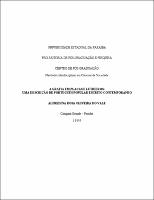| Compartilhamento |


|
Use este identificador para citar ou linkar para este item:
http://tede.bc.uepb.edu.br/jspui/handle/tede/2007| Tipo do documento: | Dissertação |
| Título: | A GRAFIA EM PLACAS E LETREIROS: UMA DESCRIÇÃO DE PORTUGUÊS POPULAR ESCRITO CONTEMPORÂNEO |
| Autor: | Vale, Alfredina Rosa Oliveira do  |
| Primeiro orientador: | Bezerra, Maria Auxiliadora |
| Primeiro membro da banca: | Monteiro, José Lemos |
| Segundo membro da banca: | Silva, Marinalva Freire da |
| Terceiro membro da banca: | Silva, Marluce Pereira da |
| Resumo: | Esta pesquisa, sob a perspectiva da produção textual, procura descrever os desvios como agentes determinadores de mudanças lingüísticas. Estes, localizados em porta-textos (o veículo condutor das mensagens coletadas), estão afixados em locais públicos de Campina Grande (PB). Identificar, a partir das incidências dos desvios, as possibilidades de mudanças no sistema ortográfico brasileiro, que poderão vir a ocorrer a médio e/ou longo prazo, é a meta principal deste trabalho. Para tal, apoiamo-nos em dois momentos teóricos: o primeiro, um estudo diacrônico, do Século XIII ao Século XX, distribuído em seis volumes HAUY, PAIVA, SPINA, MOREL PINTO, MARTINS e PIMENTEL PINTO intitulados História da Língua Portuguesa. O segundo, um estudo sincrônico, teve como ponto de partida duas obras de PIMENTEL PINTO: A Língua escrita no Brasil (1986) e O português popular escrito (1990). E, como ponto de chegada, a obra de BAGNO, intitulada Preconceito lingüístico (1999). Constatados os desvios (345 ocorrências), selecionados e categorizados, iniciamos a análise dividida em dois momentos: o desmembramento dos diacríticos e o exame das evidências (orto)gráficas em processo. Concluída a análise, foi feito um levantamento quantitativo dos desvios coletados, para observar-se a incidência das ocorrências. Os resultados obtidos acenam para uma breve acomodação fonética na língua portuguesa brasileira que, gradativamente, deverá abolir os diacríticos gerais. Quanto às evidências ortográficas, estas têm sua base nos metaplasmos de adição, subtração, assimilação e permuta. Este é o caso mais freqüente, destacando-se a substituição do grafema s pelo grafema z , quando aquele surge entre duas vogais. Os resultados ainda evidenciam o uso freqüente do anglicismo, ou da marca deste, através dos grafemas k e y . Assim, a análise conclui que sendo o ato de grafar uma situação rara para o homem comum, é esta realidade, possivelmente, que justifica o surgimento espontâneo do desvio, provocando alterações lingüísticas, execradas a princípio e aceitas posteriormente pela variante padrão. |
| Abstract: | As far as textual production is concerned, this piece of research aims at describing the deviants as determinants of linguistic changes. Such deviants found in signs and notices (i.e. the conductive means of the collected messages), are exposed in public places in Campina Grande (PB). The main objective of this work is thus to identify, from the occurrences of these deviants, the possibilities to change the Brazilian spelling rules which may come to happen in the medium and/or long term. To carry out our research, we have based the study on two main theoretical moments: the first, a diachronic study from the 8th to the 10th century, divided in to six volumes HAUL, PAIVA, SPINA, MOREL PINTO, MARTINS and PIMENTEL PINTO entitled História da Língua Portuguesa. The second, a synchronic study, had two of PIMENTEL PINTO s works as a starting point: A língua escrita no Brasil (1986) and O português popular escrito (1990) and BAGNO s Preconceito lingüístico (1999). After detecting, selecting and categorizing the deviants (345 occurrences), we started the analysis, which we divided into two parts: the dismemberment of the diacritcs and the examination of the orthographic evidences in these changes. The analysis being concluded, a quantitative survey of the collected deviants was made in order to observe the incidence of these occurrences. The results so far seem to lead to a brief phonetic accommodation in the Brazilian Portuguese which will gradually abolish the general diacritic marks. As to spelling evidences, they are based on the metaplams of addition, subtraction, assimilation, and exchange. The latter is the most frequent case, which highlights the substitution of the grapheme s for the grapheme z , when it comes between two vowels. The results still show the frequent use of anglicism, or of its presence through the graphemes k and y . Thus, the analysis concludes that by being the act of writing signs and notices an uncommon situation to the ordinary man, it is this very fact that may justify the spontaneous occurrence of the deviant, stimulating linguistic changes which are considered non-acceptable at first but are accepted by the standard variant after a certain period of time. |
| Palavras-chave: | Língua portuguesa Variante padrão Ortografia Desvio Portuguese language Standard variant Spelling Deviant |
| Área(s) do CNPq: | CNPQ::CIENCIAS SOCIAIS APLICADAS |
| Idioma: | por |
| País: | BR |
| Instituição: | Universidade Estadual da Paraíba |
| Sigla da instituição: | UEPB |
| Departamento: | Educação, Linguagem e Cultura; Políticas Sociais |
| Programa: | Mestrado Interdisciplinar em Ciências da Sociedade |
| Citação: | VALE, Alfredina Rosa Oliveira do. A GRAFIA EM PLACAS E LETREIROS: UMA DESCRIÇÃO DE PORTUGUÊS POPULAR ESCRITO CONTEMPORÂNEO. 1999. 153 f. Dissertação (Mestrado em Educação, Linguagem e Cultura; Políticas Sociais) - Universidade Estadual da Paraíba, Campina Grande, 1999. |
| Tipo de acesso: | Acesso Aberto |
| URI: | http://tede.bc.uepb.edu.br/tede/jspui/handle/tede/2007 |
| Data de defesa: | 20-Jul-1999 |
| Aparece nas coleções: | MICS - Dissertações |
Arquivos associados a este item:
| Arquivo | Descrição | Tamanho | Formato | |
|---|---|---|---|---|
| AlfredinaRosaOliveiraDoVale.pdf | 2.26 MB | Adobe PDF |  Baixar/Abrir Pré-Visualizar |
Os itens no repositório estão protegidos por copyright, com todos os direitos reservados, salvo quando é indicado o contrário.




